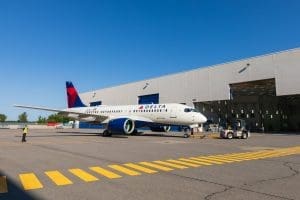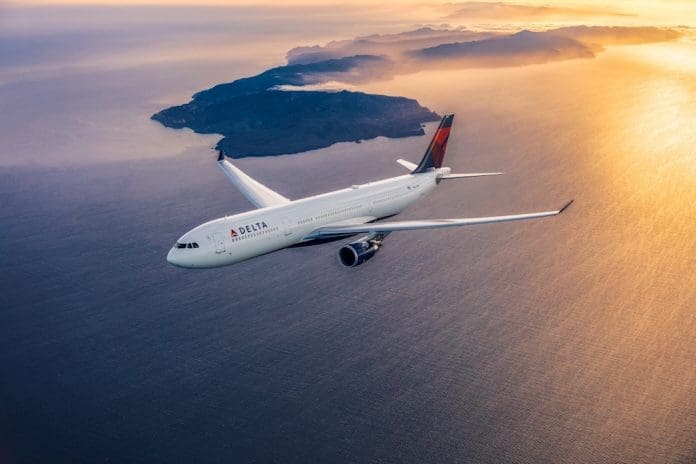Despite reporting an annual loss of over US$12.3 billion in 2020, Delta Air Lines (Delta) made good on its March 2020 promise to offset its carbon emissions. The company will paid more than US$30 million to mitigate the 13 million metric tons of emissions it contributed between March 2020 and the end of the year. “Connecting the world and protecting our environment for future generations cannot be mutually exclusive,” said Delta CEO Ed Bastian. “Travelers should not have to choose between seeing the world and saving the world. We must continue to take immediate actions today and can’t wait for future solutions to become a reality. While there are many paths to carbon neutrality, Delta chose to make an impact today and invest in a future where aviation itself becomes cleaner for the world around us.”
Delta’s Climate Pledge
On February 14, 2020, just weeks before the United States entered a nationwide lockdown, Delta released an ambitious climate pledge to allocate US$1 billion over the next 10 years to mitigate carbon emissions. “There’s no challenge we face that is in greater need of innovation than environmental sustainability, and we know there is no single solution. We are digging deep into the issues, examining every corner of our business, engaging experts, building coalitions, fostering partnerships, and driving innovation,” said Bastian. “We are on a journey, and though we don’t have all the answers today, we know that our scale, along with investments of time, talent, and resources will bring meaningful impact to the planet and ensure the sustainability of our business for decades to come.”
Although the pledge pertains to all of Delta’s business, the company notes that 98% of emissions come from its aircraft. In order to combat climate change, Delta wants to target carbon reduction, carbon removal, and stakeholder engagement. Details of the initiative are as follows:
Carbon reduction: Reducing Delta’s carbon footprint through enterprise-wide efforts to decrease the use of jet fuel and increase efficiency. Areas of focus include an ambitious fleet renewal program, improved flight operations, weight reduction, and increased development and use of sustainable aviation fuels (SAFs).
Carbon removal: Investing in innovative projects and technology to remove carbon emissions from the atmosphere that go beyond the airline’s current commitments, and investigating carbon removal opportunities through forestry, wetland restoration, grassland conservation, marine and soil capture, and other negative emissions technologies.
Stakeholder engagement: Building coalitions with employees, suppliers, global partners, customers, industry colleagues, investors, and other stakeholders to advance carbon reduction and removal goals and maximize global impact.
In this way, Delta’s climate pledge is tackling all three elements of ESG, environmental, social, and governance. “When customers choose to fly Delta, they should feel they’re making a statement about taking care of our planet,” said Bastian. “Our commitment to carbon neutrality means flying with Delta represents far more than a great travel experience — it’s about joining arms to create a better world.”
How Delta Will Use the US$30 Million Pledge
According to Delta, the 13-million-ton offset is equivalent to the carbon sequestered by 17 million acres of US forests in one year. In response to the COVID-19 pandemic, Delta cut many of its flights in 2020. Its carbon offset budget could easily top US$100 million a year as air traffic starts returning to 2019 levels. In addition to the US$30 million investment, Delta retired over 200 of its aircraft, replacing them with planes that are 25% more fuel efficient per seat mile. Delta estimates it saved nearly 120 million gallons of jet fuel from retired fleets and lower passenger volumes.

Image Courtesy Of Delta Air Lines
Looking ahead, Delta plans on investing in SAF, which is carbon-neutral fuel derived from sustainable feedstocks like plants. However, Delta notes that SAF and carbon sequestration are not available on a large enough scale to meet the industry’s demands. In fact, Delta says that all SAF produced in 2020 would only be enough to power its pre-pandemic fleet for one day. Given that SAF is still in its infancy, Delta’s preliminary estimates say that 10% of its jet fuel will be replaced by SAF by the end of 2030. The company has also agreed to purchase 10 million gallons of SAF from Gevo starting in 2024 and 60 million gallons from Northwest Advanced Bio-Fuels starting in 2025. Together, the 70-million-gallon contracted supply is less than 2% of Delta’s annual fuel consumption. It’s a start, but the company has a long way to go if it wants to hit its 2030 goal.
Delta’s attitudes toward SAF are similar to another airline dedicated to reducing emissions: JetBlue. One of the ways the company is investing in SAF is by building pipelines that make the fuel more readily accessible for some of its largest hubs (see Blue Skies Ahead, ESG Review: First Quarter 2020, p. 4).
Other Investments
Aside from directly offsetting emissions through carbon credits and sequestration, Delta is investing in carbon, capture, and storage (CCS), as well as innovations in propulsion, post-combustion emission control, electric power delivery, and fuel cells. Given the limitations of SAF, Delta sees CCS as a more scalable option that can work well for industries like aviation that don’t have a lot of options for reducing emissions. As far as other technologies, the company would need to completely retrofit its existing fleet and build out its infrastructure. Hydrogen fuel cell technology has come a long way in the past few years, particularly in the commercial transportation industry through trucks and buses. However, the technology is virtually nonexistent for commercial aviation at this time.
Short- And Medium-Term Carbon Offset Plans
Delta has three main ways to reduce emissions. Similar to JetBlue, Delta is investing in carbon avoidance projects (avoiding emissions altogether by using renewable sources instead of fossil fuel sources), carbon reduction projects, and carbon removal projects.

Over the short- and medium-term, Delta’s main way to reduce emissions will be through carbon offset projects. Most notable are the Rimba Raya and the Keo Seima, two projects that protect forests through a community-driven conservation model involving local communities in Indonesia and Cambodia. These investments support the cost of running the programs and conserving more than half a million acres of forests while avoiding the release of an average of 5 million metric tons of carbon to the atmosphere per year. “These Delta investments provide the necessary financial stability for projects to protect forests and their vast capacity to store carbon — the original technology provided by nature,” said Gerald Prolman, CEO of Everland LLC, a company that joins corporations and communities to protect some of the world’s most at-risk natural habitats. “In addition, the projects promote sustainable livelihoods, conserve critically endangered species, support the preservation of indigenous communities’ culture and traditions, and maintain the natural resources on which forest communities depend.”
Leading The Charge
By offsetting emissions, partnering with communities, and building a company that helps all of its stakeholders (not just shareholders), Delta’s carbon-neutrality plan embodies the essence of ESG. These actions are all the more impressive considering Delta is coming out of its worst annual financial performance in history. Given the company’s steadfast dedication and decision to allocate much needed cash toward reducing emissions, Delta is setting a good example for the airline industry as a whole.
















